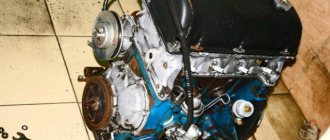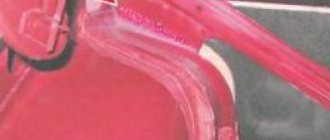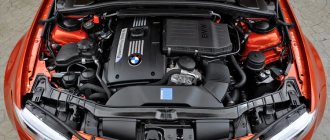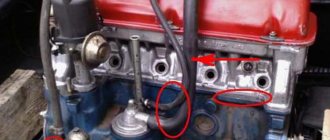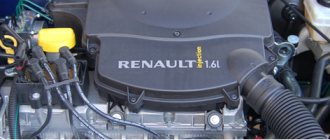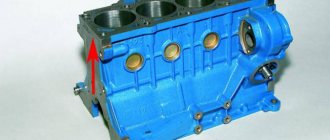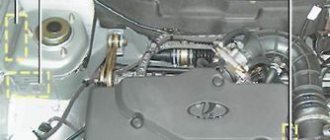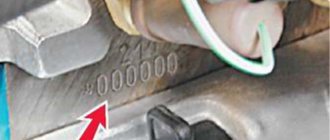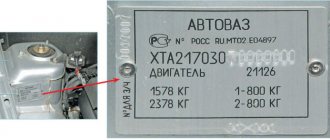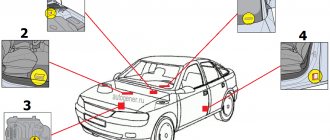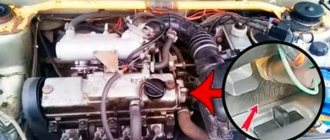On VAZ cars, the identification number (VIN) is stamped and located in the engine compartment:
- VAZ-2101, VAZ-21011, VAZ-21013, VAZ-2102, VAZ-2103, VAZ-2104, VAZ-2105, VAZ-2106, VAZ-2107 and their modifications - on the bottom shelf of the air supply box on the right in the direction of travel
- VAZ-2108, VAZ-2109, VAZ-2110 – on the upper surface of the right pillar of the body mudguard (on the right front suspension spring support)
- VAZ-2121 - on the upper amplifier of the front panel on the right. In addition, there are options for the following location - on the upper reinforcement of the radiator trim panel, on the front panel next to the nameplate
For the first five years since the start of production of VAZ cars (1970-1975), the vehicle identification number was applied to the vertical wall of the air intake box on the right in the direction of travel.
The identification number (VIN) on VAZ cars produced before 1982 consisted of 11, 12, 14 and 15 characters. The last seven digital characters indicated the serial number of the product, and the first seven (eight) alphanumeric characters or four (five) digital characters, respectively, either the manufacturer and the car model, or the car model. Dividing marks are made in the form of five-pointed stars.
★ VAZ 2101 0000001 ★ I II III
★ 2101 ★ 0000001 ★ II III I—manufacturer II—car model III—product serial number
Since 1982, the vehicle identification number consists of seventeen 10 mm high characters and is enclosed between two asterisks.
Photo. Type of identification number applied to VAZ-2101-VAZ-2107 cars and their modifications since 1982.
The distance between the conventional centers of dividing signs is 106-107 mm, the height of the signs is 10 mm, the width of the signs is 4 mm, the distance between the signs is 2 mm.
★ HTA 2106 00 C 0000001 ★ I II III IV V
I - number of the world manufacturer II - car model III - signs that do not carry information (no meaning) IV - year of manufacture of the car V - serial number of the product
The body for spare parts is always produced with its own number (seventeen characters), and the marked parts of the body for spare parts are produced without a number.
Location of engine number VAZ 2107 carburetor and injector
From time to time, car enthusiasts are faced with the need to look up the engine number of a VAZ 2107 or similar models for a census or to clarify some data.
To perform the operation, you do not need to perform any “dances with a tambourine.” You need to know where the markings are applied. It should be understood that during the production period, the manufacturer changed several power plants, which imposed certain peculiarities on the location of the data. The following indicates where to look for the appropriate markings, and also deciphers the VIN - vehicle number.
Numbers of gasoline engines 1.5: 68 and 71 liters
Next, the manufacturer began to install installations of a more productive and modern type.
The outdated carburetor was replaced by an advanced injector. ICEs were relevant until 2006. After that they were discontinued. Here the number is also written using the percussion method - the coding is stamped on the metal. In such engines, the number is mainly marked on the block slightly above the oil filter.
Why do you need to know this?
Buying a car is a joyful event. But it may be overshadowed by the fact that during registration, unpleasant details will be revealed. Therefore, ALWAYS check that all vehicle identification data matches those indicated in its documents!
Of course, in different regions of the country, car inspectors have different views on the fact that a car may have an engine with a number that differs from what is indicated in the documentation. But traffic police officers may quite reasonably have questions if suddenly the engine number does not match. Isn't the motor you have stolen? Was it installed legally?
If the engine has been replaced on the car, then there must be all the documents that would confirm the legality of its installation.
Source
About the G8 in detail
A car with a metal frame of a 3-door all-steel sheet-welded supporting structure belongs to cars of the 2nd category of the small class. The hatchback was designed at the Volzhsky plant back in 1984.
Body of the new VAZ 2108
The production of front-wheel drive cars has been tempting designers since time immemorial, although a comprehensive switch to such a conveyor belt at the global level began only in the mid-70s. The disadvantages of front-wheel drive cars were considered to be the unsatisfactory condition of the entire node circuit. Handling, engine and suspension left much to be desired.
On the other hand, the mere fact that the internal combustion engine was located transversely when the front drive wheels were in operation made it possible to transform a small class car into an ultra-compact and lightweight version of the vehicle. VAZ adopted such designs in 1971, and first a couple of experimental samples were manufactured at the car plant. As for the G8, this front-wheel drive car was released in 1978, although it was put on the production line only in 1984.
VAZ 2108 new body
The advantage of the G8 was considered to be that certain of its units and mechanisms were made crossed with parts from such a grandee of the auto world as Porshe.
The exterior of the G8 at first implied the presence of a shortened wing at the front. In fact, this approach was determined to be not very practical, since the plastic component soon deteriorated and stretched under the influence of ultraviolet radiation. Then another project came into force, implying a different, modernized design of the front part of the G8. These were similar parts, but noticeably elongated. The front end has been modernized with a new grille with a modern “face”.
The interior also left much to be desired at first. The dashboard sat low, but after restyling in '91 it was corrected with a raised panel that was more convenient for the driver. In addition, on the restyled G8 they began to equip the dashboard with a tachometer instead of a voltmeter.
Cars with a body like a VAZ 2108
The “Eight” is rightly called the first car with front-wheel drive after the “classics”. With the release of a new conveyor, a new production line opens, from which not only “eights”, but also “nines” come out.
It is noteworthy that the “eight” marked the beginning of a new series of cars called “chisel” due to the angular shape of the hatchback body.
The presence of 2 doors instead of 4 was associated in that era as features of a sports car. And indeed, due to its lightweight and good, powerful internal combustion engine, the “eight” will become the favorite of young people of that time and will make it easy to overtake on the road the heavy and not very maneuverable images of VAZ models from the “classic” series.
Body for VAZ 2108
The “Eight” is equipped with a body that can be called universal. Absolutely all of its components form a single whole, implying a connection by spot welding and strengthening of some elements that bear a heavy load with an additional welding arc. Some attached parts, the “tail” of the car, are connected to the frame with strong, special type bolts. You can read more about the details of the VAZ 2108 frame in the table below.
Where is the engine number on the VAZ-2107
The number of cars owned by citizens of our country increases from year to year. Theft statistics are also growing steadily. Therefore, the identification of each vehicle remains an extremely pressing problem. In this sense, the engine marking of a car (and the VAZ-2107 was no exception) is considered an irreplaceable and unique attribute that helps distinguish one vehicle from another, otherwise similar. The problem is that many people still have no idea where exactly the number on the “seven” should be. This article will help you understand the issue.
Why is the identification number checked?
As practice shows, a considerable number of car enthusiasts do not even imagine why it is necessary to check the number of the engine, body and other units. Meanwhile, the attribute discussed in this article is the only thing that distinguishes one machine from a similar one. If it did not exist, then a person would, in principle, be unable to prove his ownership of the Zhiguli that is at his disposal. Such uncertainty would prevent:
Of course, car owners rarely encounter situations in which it becomes necessary to accurately identify a car. Moreover, they even stopped entering information about the license plate into the car’s registration certificate. This practice existed until 2011.
However, the vehicle ID is still checked when it:
And if in the first of the mentioned cases the comparison of data is carried out by the owner and the potential purchaser, then in the second this responsibility is assigned to representatives of the State Traffic Inspectorate. They, in turn, enter the information into a special database, and in the future, if even one number does not match, the owner of the VAZ-2107 may have certain difficulties with legalizing the car.
If a successful combination of circumstances occurs, a person will only have to re-issue documents, which will require evidence of replacing the same engine. Moreover, in the case of the body, even this will not help, since the law does not provide for its replacement. Without the documents in order, the vehicle will have to be hidden in the garage.
Specifications
VAZ 2114 car
The technical characteristics of the VAZ 2114 engine are quite typical for the 2113-2115 series of cars. In addition, this power unit is developed on the basis of the “eight” engine, which has declared itself to be reliable and easy to repair. The car was produced from 2001 to 2013. During this period, the vehicle received five valuable power units.
VAZ 2114 engine structure
As was said earlier, the 2114 was equipped with five different power units, which differed in power and valve mechanism. Three of them had 8 valves, and the other two had 16. The gas distribution mechanism had a belt drive. Until 2007, the engine was equipped with a simple on-board computer, which did not regulate the operation of the engine based on sensor readings. Therefore, the motorist had to regulate the processes the old fashioned way, manually. Since 2007, an ECU was installed, which, receiving data from sensors, independently adjusted many processes.
Design features of the engine.
Since the second generation had a so-called two-way electronic engine control unit, it is worth considering what electrical circuit was installed.
Electrical diagram of a VAZ 2114 car.
Where exactly is the engine number?
The VAZ model 2107 was supplied to the market with several power units. The first cars rolled off the assembly line with engines of the carburetor system, which also went to the Zhiguli 2103 model. Later they were replaced by units used on the VAZ-2105 and 2106. All of them had a volume of 1.3 liters. Moreover, in export versions more powerful engines were used - 1.7 liters.
Regardless of the engine type, its identifier must always be in one of three places. The digital sequence is applied using the impact method, a special machine and a special font.
The engine number of the 2107 model is most often found on the left side (in the direction of travel) of the cylinder block. For cars produced after 2000, you should look for it in the oil filter area, on the right.
If there is no identifier in any of the specified locations, then all that remains is to inspect the area of the block adjacent to the air duct. There are no more options.
Searching for information on a surface contaminated with dust and grease is quite difficult. To make the task easier, first wipe the area with a cloth soaked in gasoline. It is recommended to carry out this procedure with special care before registering the vehicle with the State Traffic Inspectorate.
Information plate
Separately, it is worth noting the information table that is located on the right on the front pillar. The table contains a duplicate engine and body number. In addition, information is included about the year in which the car was produced, the plant that produced it, etc. In fact, all that information that is a priori basic.
However, the fact that it only duplicates meanings does not detract from its importance. This means that her condition should also be good.
If there are small areas of rust, you need to get rid of them; if there are small chips, which make access to information difficult, then, if possible, the plate needs to be replaced. Ideal condition - smooth surface without rust and the presence of rivets that fix it to the car body.
How to decrypt a number
Initially, the Volzhsky Automobile Plant used 7-digit numbers. However, in 1987, the 9,999,999th car rolled off the assembly line, after which a reset occurred. For this reason, in order to avoid confusion, in addition to the identifier, you should also take note of the production date.
Body marking has three attributes. The first line contains a Latin letter (from A to H), which indicates the type of installed equipment. Next comes the abbreviation of the enterprise (VAZ). The last line contains the date in the format “DD.MM.YY”. Following it, the letter designation of the shift is indicated (N or K) and the body type - 2107.
The engine number is written in two lines. At the top there is the model name (2107), and below is the actual identifier. Until the beginning of 1982, it contained from 11 to 15 characters. Moreover, only the last 7 characters were the serial number. The first numbers, separated by an asterisk, indicated the manufacturer and specific modification.
After the specified year, the number became 17 digits. In this case, the first three letters are XTA - the international code of the domestic automaker. Then the car model is given - 4 digits, that is, 2107. The next 2 positions are reserve, and in our case - two zeros. Next, a Latin letter is stamped, symbolizing the year (for example, 2000 is Y). The last 7 are the engine serial number.
Source
Numbers on engines of subsequent generations of Lada cars
Where is the engine number on a VAZ?
Knowing where the car engine number is located is useful for any motorist; it is especially important to know its location when buying a car, as well as repairing and replacing the engine.
From a verbal description, of course, it is not easy to immediately understand where the engine number is on a VAZ, so I propose to consider the location of the engine number on various car models.
Location of the engine number on VAZ 2101, 2102, 2103, 2104, 2105, 2106, 2107
Location of the engine number on VAZ 2101, 2102, 2103, 2104, 2105, 2106, 2107:
Location of the engine number on the VAZ 2107 and the latest VAZ 2104:
Location of the engine number on VAZ cars of the eighth, ninth and tenth families
Location of the engine number on VAZ 2108, 2109, 21099:
Location of the engine number on the VAZ 2110:
Location of the engine number on VAZ 2111, 2112:
Location of the engine number on VAZ 2114-2115, 2113:
Location of the engine number on VAZ Niva cars
Location of the engine number on the VAZ Niva:
Location of engine number on Chevrolet Niva:
Engine number for VAZ 2110, 2111, 2112, 2113:
Engine number on the classic VAZ 2104, 2105, VAZ 2106, VAZ 2107, Niva:
The engine number is not readable, what should I do?
Source
VESKO-TRANS.RU
AutoNews / Reviews / Tests
Where is the Body Number on the VAZ 2107
Body for VAZ 2107: structure, diagram, replacement
The VAZ 2107 car has long been a legend in the Russian automobile industry. Everyone knows their outstanding body in traditional color with conventional geometry. Being a luxury version of the VAZ 2105, it was produced from 1982 to 2012 in several versions, with various configurations, including. the body .
Car body
body
VAZ 2107 is a 4-door rear-wheel drive car. The assembly diagram of its frame is standard and has the following elements:
- Front parts;
- Front fenders with reinforcements;
- Roofs with glass frames;
- Reinforced floor and backsplash;
- Side parts;
- Hind wings
Who is this element cast from mild steel. Each part is equipped not only with its own number, casting chart, but also with a newspaper of personal thickness. For example, 0.9 mm for the roof, 1.0 mm for the rear wheel arch.
Most parts are connected by non-contact welding, but parts with high loads are additionally strengthened by arc welding.
Suspension parts include the following:
Detailed diagram of the machine
The bumper elements are made of plastic, attached with brackets, and have a chrome finish.
There is a lot of space inside the car. The front seats are adjustable using the backrest and fore/aft position. The rear seat is three-seater.
What else remains for our client, the glasses are not of a dangerous type, and the well-thought-out design of the car will reduce the impact in an accident.
Dimensions and specifications
Regardless of your configuration, the VAZ 2107 has the following dimensions:
The motorist must know not only the standard characteristics of his car, but also the control dimensions.
